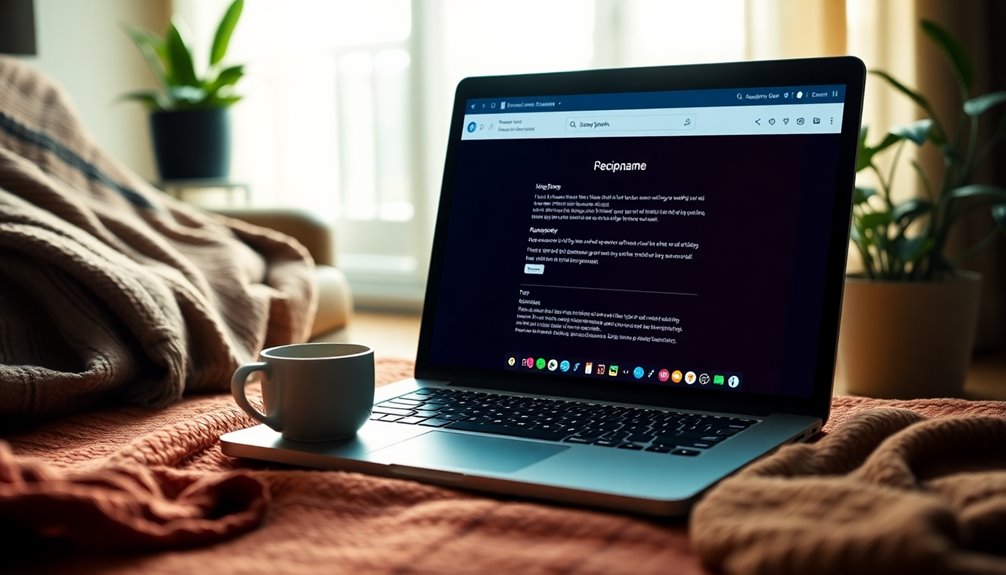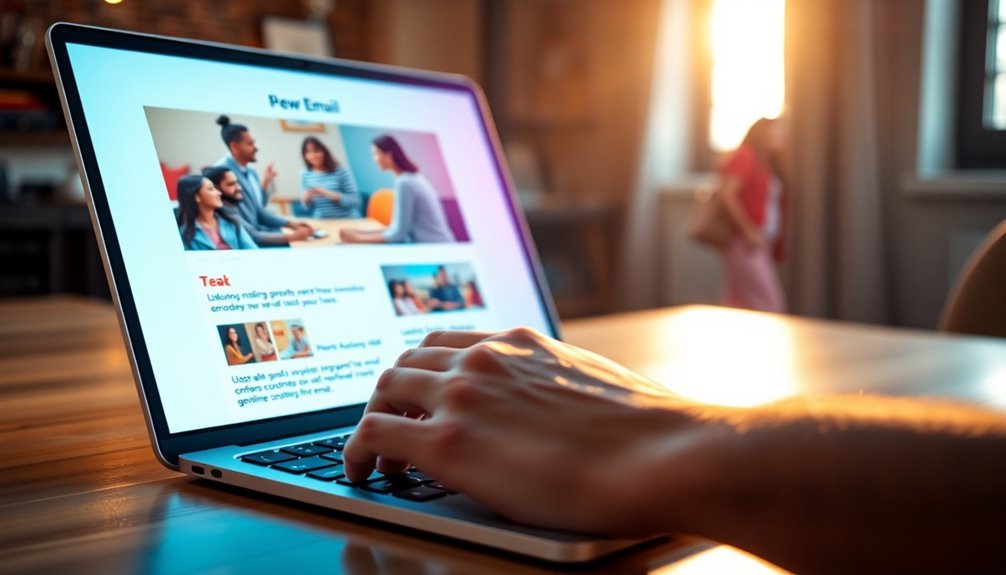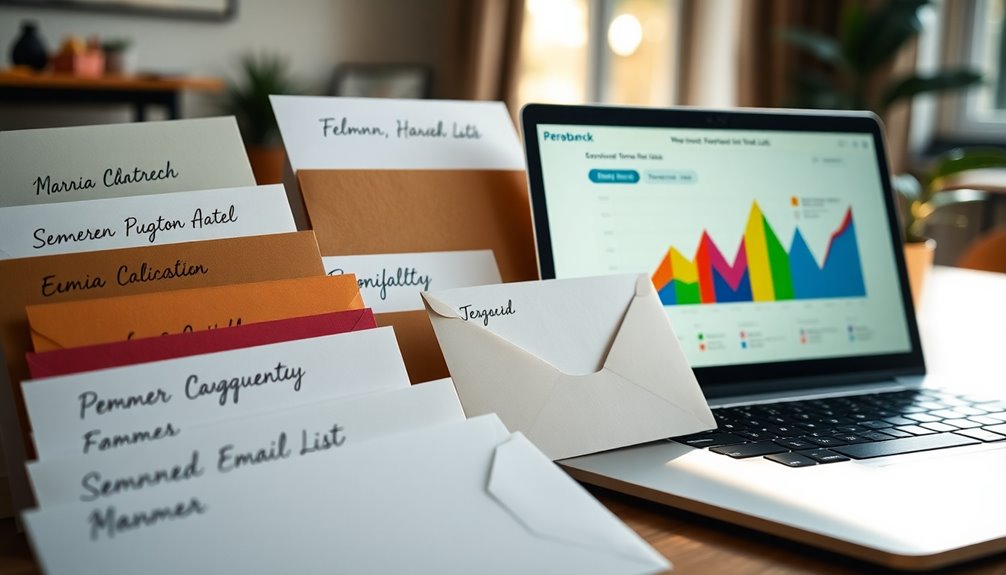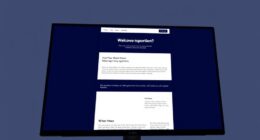Personalized emails are your quickest route to building trust with customers and solidifying lasting relationships. They boost engagement and make your audience feel valued. When you tailor messages with your customers' names and interests, you increase open rates by 26% and drive click-through rates by 139%. Understanding your customers through data helps you craft relevant content that resonates. By keeping your emails timely and focused, you reinforce your brand's credibility and connection. Stick with best practices, and you'll see significant results. You'll discover additional insights to enhance your approach ahead.
Key Takeaways
- Personalize email content to resonate with customer interests, enhancing relevance and trust in your brand communications.
- Use recognized sender names and unique subject lines to establish credibility and increase open rates.
- Segment your audience based on behavior and preferences to send tailored messages that foster stronger connections.
- Incorporate emotional storytelling and value-added content to create relatable and trustworthy interactions with your customers.
- Automate follow-up emails based on customer actions to ensure timely communication and reinforce reliability.
Importance of Trust in Business

Trust is the cornerstone of successful business relationships. You know that building trust with customers is essential for retaining them long-term.
When customers trust you, 33% are willing to pay a premium, and 91% are more likely to buy from your company. However, losing that trust can hit your revenue hard; 71% of customers will spend less, and 44% may stop buying altogether.
Your brand reputation plays a crucial role here, as 46% of business leaders prioritize it. Factors like reliability, competency, and integrity also influence trust significantly. Moreover, trust directly correlates with customer loyalty which further emphasizes the importance of fostering trust in your business practices.
Benefits of Personalized Emails

Personalized emails are a powerful tool for enhancing customer relationships and driving business success. They boost your brand's credibility by showing customers you understand their preferences. When you send relevant content, like timely reminders or customized offers, it resonates with your audience, making your brand more relatable. This leads to higher open rates—26% more likely—because your subject lines match their interests. Personalized subject lines significantly increase the chances of your emails being opened, further amplifying engagement. Additionally, cultivating an abundance mindset can transform your approach to customer interactions, making them feel valued and appreciated.
Engaging content keeps customers hooked, resulting in a 139% increase in click-through rates. Plus, personalized emails show genuine care, improving customer satisfaction and loyalty. Ultimately, they deliver a higher ROI, making your marketing efforts more efficient and effective in building long-term relationships. Embrace personalized emails to create a meaningful connection with your customers.
Understanding Your Customers

Understanding your customers is crucial for building strong relationships and driving business success. Start by creating a buyer's persona that defines your ideal customer through demographic and psychographic data. Gather insights on their age, interests, and lifestyles, and analyze their purchase history to spot trends. Additionally, adopting a holistic SEO approach can help you understand customer behavior more effectively.
Next, seek direct feedback through surveys and focus groups to refine your understanding of customer needs. Monitor social media to gauge sentiment and adjust accordingly. Additionally, analyze competitors to identify market gaps and innovative strategies that could enhance your offerings. Remember that understanding customer needs drives product selection and influences marketing strategies.
Finally, leverage data-driven insights, such as customer segmentation and predictive modeling, to tailor your approach and foster deeper connections with your audience. This understanding lays the groundwork for effective personalized communication.
Crafting Personalized Email Content

When you tailor your email content to match the unique preferences and behaviors of your audience, you significantly enhance engagement and build stronger connections. Start by employing segmentation techniques like demographic, behavioral, and geographic segmentation to address specific needs. Dynamic content blocks allow you to customize messages based on individual preferences, while personalized subject lines and greetings make your emails feel more personal. Additionally, remember that effective email marketing can yield an impressive $36 return for every $1 spent, reinforcing the importance of personalization. To maintain content quality, ensure that your emails provide valuable information that resonates with your audience and a clear call-to-action that guides them toward the desired action.
Timing and Frequency of Emails

Effective timing and frequency of your emails can significantly influence customer engagement and retention. Consistency matters; sending emails at regular intervals keeps your brand top of mind and prevents decreased awareness. Aim for a frequency of 1-3 emails per month to avoid overwhelming subscribers while ensuring they receive updates. Remember, one monthly email is the minimum to maintain visibility. Testing different frequencies can reveal important insights about customer preferences that resonate best with your audience and allows them to choose their preferences. Monitoring engagement metrics like open and click-through rates will help you adjust your strategy accordingly. By finding the right balance, you can maximize engagement and build trust without causing email fatigue among your subscribers.
Segmenting Your Email List

Building on your email timing and frequency strategy, segmenting your email list takes personalization to the next level.
You can categorize your customers based on demographics, behaviors, preferences, and lifecycle stages. For instance, using demographic data helps tailor content for different age groups, while behavioral segmentation allows you to engage customers based on their purchase history. Additionally, employing data-driven marketing strategies can enhance the effectiveness of your segmentation efforts.
Preference-based segmentation ensures you send relevant recommendations, and lifecycle stage segmentation nurtures relationships at every point. Furthermore, analyzing email engagement can help you adjust content and frequency, leading to higher engagement rates that improve overall campaign effectiveness.
Measuring Email Effectiveness

To truly understand how well your email campaigns are performing, it's essential to measure their effectiveness using key metrics.
Start by assessing the deliverability rate, which shows the percentage of emails reaching inboxes; aim for above 90%. Regular analysis of email metrics is crucial for continuous improvement. Additionally, maintaining a good privacy policy can enhance user trust and email engagement.
Next, check your bounce rate—keep it below 5% to ensure quality addresses.
The open rate reveals how engaging your subject lines are; strive for over 15%.
The click-through rate (CTR) indicates the effectiveness of your calls-to-action, with a target above 15%.
Lastly, monitor the click-to-open rate (CTOR) to evaluate content quality and placement, aiming for over 20%.
Examples of Successful Campaigns

Analyzing email effectiveness paves the way for understanding what drives customer engagement.
Successful campaigns leverage segmentation and personalization, like Spotify recommending playlists tailored to your tastes or Airbnb sending accommodation suggestions based on your interests. Email personalization can boost revenue by up to 760%, making it a crucial strategy for businesses.
Location-based personalization shines, too; Uber shares local deals, while Ticketmaster highlights nearby events.
Value-added content, such as Adobe Creative Cloud's software tips, reinforces brand trust.
Emotional storytelling resonates, as seen when H&M sends birthday discounts that feel personal.
Finally, automation plays a key role, with Grammarly guiding users through onboarding via a series of helpful emails.
These examples illustrate how personalized emails can engage customers, build trust, and ultimately enhance your business relationships.
Best Practices for Email Personalization

Email personalization isn't just a trend; it's a necessity for engaging customers effectively.
To get started, research email marketing services that offer scalability and integration with other platforms. This makes managing personalization easier and more efficient.
Use a recognized sender name—people respond better to real names and photos. Personalization can also enhance subscriber engagement by making emails feel more relevant and tailored to individual preferences.
Craft unique subject lines by incorporating the recipient's name or interests to boost open rates.
Don't forget to personalize the content; a welcoming greeting and tailored calls to action can significantly enhance engagement.
Lastly, automate your emails to streamline communication based on customer actions, ensuring timely and relevant outreach.
Frequently Asked Questions
How Can I Gather Customer Data for Personalization?
To gather customer data for personalization, you can start with direct interactions like customer accounts and transaction histories.
Monitor website behavior and utilize product recommendation quizzes to understand preferences.
Leverage social media insights to analyze engagement and segment audiences.
Additionally, track purchase frequency and cart abandonment to refine your approach.
Collect feedback through surveys and integrate data from various channels using CRM systems for a comprehensive view of your customers.
What Tools Can Help With Email Personalization?
Imagine sending a generic email, like serving plain tofu at a gourmet dinner—yawn!
You need tools that jazz things up. Saleshandy lets you sprinkle in fancy features, while Smartlead segments your audience like a pro chef slicing veggies.
Lemlist customizes with flair, and Instantly.ai uses AI magic.
Don't forget Reply.io's dynamic profiles and Lavender's real-time tweaks.
With these tools, your emails won't just be read, they'll be devoured!
What Should I Avoid in Personalized Emails?
When crafting personalized emails, avoid common pitfalls that can undermine your efforts.
Don't send messages with bad variable names or blank values; double-check your data for accuracy.
Be cautious not to use the wrong names or over-personalize, as this can feel intrusive.
Also, steer clear of irrelevant recommendations and ensure your emails have a clear purpose.
Lastly, don't forget to send at optimal times to maximize engagement.
How Do I Handle Negative Responses to Personalized Emails?
When you handle negative responses to personalized emails, stay calm and professional. Acknowledge their concerns and thank them for their feedback.
Look for constructive criticism and identify patterns in their responses. Use this insight to refine your message and target the right audience.
Remember to accept rejection gracefully, maintain a positive attitude, and view each response as an opportunity for improvement.
This approach will help you enhance your future outreach efforts.
Can Personalized Emails Improve Customer Retention Rates?
Imagine your email as a warm handshake, welcoming customers into your brand's world.
Yes, personalized emails can significantly improve customer retention rates. By tailoring messages to reflect their preferences and behaviors, you create a bond that keeps them coming back.
When customers feel seen and valued, their loyalty deepens. Think of it as planting seeds of trust, which flourish into lasting relationships that benefit both you and your customers.
Conclusion
In a world where trust is the currency of business, personalized emails can be your secret weapon. By understanding your customers and speaking directly to their needs, you're not just sending messages—you're building relationships. Imagine the loyalty you could inspire! So, embrace the power of personalization, and watch your customer connections thrive. After all, when your emails resonate, trust follows, and your business flourishes. Don't you want to be the brand they can't ignore?










